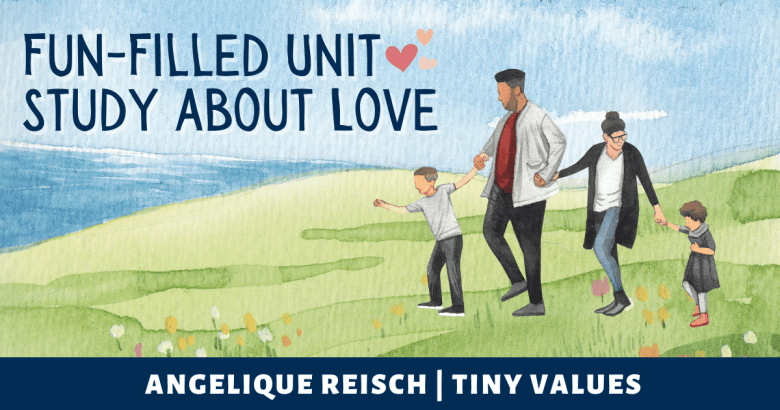By Angelique Reisch of Tiny Values
Love is in the air, and what better way to celebrate it than to teach a fun homeschool unit study all about Love!
This study is full of heart and an incredible dive into character development with a sprinkle of sign language, math, and science! Packed with actionable exercises, get your red food coloring ready; let's learn about that most wonderful feeling… Love!
Character Development: Love's Many Facets
Defining Love:
Love is a magical feeling that can be sparked by different things. It might be a warm hug from someone we care about, a kind word, or even spending time with a beloved pet. Acts of kindness, shared moments, and connections with others can trigger the beautiful emotion of Love, making our hearts feel full and happy.
Exercise: Start by asking your children, "What is love?"
Have them make a list of five things they love. This exercise will give them a little gratitude boost as well!
The Anatomy of Love:
Discuss how to love someone requires:
- Selflessness - putting others first
- Vulnerability - being our true selves
- Courage - to put our feelings out there even if they aren't reciprocated
- Understanding - accepting and forgiving others
Project: Have your children draw a big heart and split it into four pieces. Then, write one of the above words in each section.
Five Things I Love About Me:
Now is a great time to discuss self-love with your children and do a confidence exercise.
Self-love means being a good friend to yourself. It's like giving yourself a warm hug, saying kind words, and feeling proud of yourself.
Project: Have your children draw a self-portrait, and then, around the picture, have them write five things they love about themselves. Then, you write five things you love about them around the image. This drawing will be a wonderful reminder of how special and loved they are.
2. Sign Language: Expressing Love with Hands
I loved teaching my children sign language for Love. Once they understood this simple gesture could convey so much emotion without a single word, they used it everywhere we went!
It became our secret language to communicate in any situation. I still use it when I have to say "no" to something like an extra Oreo cookie. It's a gentle reminder that I'm doing it out of Love.
Exercise: Have your children practice making the sign for Love.
3. Discover your child's love language
There has been so much talk about love languages for couples, but did you know your child also has a love language? Determining your child's favorite way to be loved will help you understand what form of affection they prefer, allowing you to connect with them more deeply.
- Words of Affirmation - If your child responds to verbal compliments the most, you can go out of your way to reassure them of your Love with constant verbal affirmations, notes, or cards.
- Gifts - Of course, every child loves gifts, but for some children, receiving a physical reward means more than a hug or an "I love you."
- Acts of Service - Children who have this as their love language appreciate everything you do to care for them, from making lunches to folding clothes to cooking dinner.
- Quality Time - If your child wants to be the center of your world and craves a lot of screen-free play time, they may speak this love language.
- Physical touch - This may be their love language if your child often wants extra hugs, kisses, or snuggles.
Exercise: To determine your child's love language, ask them, "What's your favorite thing I do to make you feel loved?" You can also observe how they tend to show you love. We often offer Love in the way that we most desire to receive it ourselves.
4. Literature: The Invisible String Connection
If you're looking for a fantastic book about Love for all ages, I highly recommend "The Invisible String" by Patrice Karst. This book beautifully illustrates that an invisible string of Love connects us even when we’re physically apart.
This book will open up a deeper conversation about Love with your children. It will also give them the confidence to know that even when they're apart from us, they're still cherished and cared for.
5. The Invisible String Connection Wall
Project: Bring the Invisible String concept to life with a DIY project. Hang fairy lights on a wall and encourage your child to print out and clip photos of everyone who loves them to hang on the lights.
There's magic in this because they'll see those photos every day, and every time they do, they'll get a boost of endorphins in their brains. It will remind them of all the people in their lives who love them and just how special and connected they are.
6. Math in the Kitchen: Baking Valentine's Day Treats
What better sweet thing to add to a unit about Love than to bake up some delicious heart cookies? This part of the unit is sweet and educational as your little bakers learn all about math, exploring measurement and fractions while mixing ingredients. This hands-on activity enhances mathematical skills and makes learning a treat.
Project: This cherry thumbprint cookie by Catherine Zhang uses thumbprints to create adorable hearts. Bake these up or your favorite heart cookie recipe!
7. Science of Love: Chemical Reactions in the Brain
When we feel Love, our brain releases special chemicals that make us feel happy and connected. One of these chemicals is oxytocin, often called the "love hormone."
It creates warm, fuzzy feelings and strengthens bonds with others. Dopamine, another chemical, adds excitement and joy. These reactions in our brain make Love a powerful and wonderful experience, creating positive emotions that stay with us.
Project: Take a clear cup of water and some red and blue food coloring. The red is the oxytocin, and the blue is the dopamine. Drop three drops of each into the cup of water.
In the cup, they mix to create an exciting color. This exercise builds a simplified visualization of what happens when oxytocin and dopamine release in our brains. Our brains combine these hormones to develop positive feelings of deep Love and connection with others.
Conclusion
We hope you enjoy these fun exercises all about Love! Love is not just for Valentine's Day, as we keep it alive all year long by paying attention to our children's love languages, creating visual reminders in our homes of how much they're loved, and talking about how we're connected by Love, even when we're apart.
Tiny Values is honored to help you spread Love in your families and your homeschool with this Fun-filled Unit Study on Love.
Read More!
- Log in to post comments

